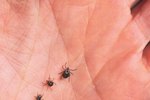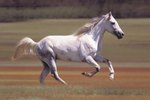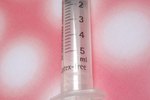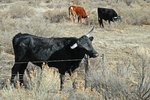
Flies not only make cattle miserable, they also can transmit disease and impede weight gain. The annual fight against flies is now easier because of the availability of insectide-impregnated ear tags for cattle and calves. Perhaps the biggest advantage is pointed out by the University of Kentucky Department of Entomology, which states, "With insecticidal ear tags, the control system moves with the animals."
Ear Tags
While there are many insecticide-impregnated ear tags designed for cattle on the market, they fall into three basic categories. Tags either contain organophosphates, synthetic pyrethroid insecticides or a combination of the two. For best results, you might not want to use the same type of pesticide two years in a row. Rotation helps combat the development of insect resistance to the insecticides. Once attached, ear tags generally provide effective fly control for three to four months.
Flies
Ear tags provide protection against horn flies, that bovine scourge that might bite each animal between 30 and 40 times daily. Multiply by that by hundreds of flies, and it's easy to see why keeping these pests off cattle is so important. However, the University of Kentucky recommends not tagging cattle until the number of horn flies reaches 50 insects per each side of the cow, in order to reduce the odds of the flies developing a resistance. Face flies, another source of bovine woe, are a primary cause of pinkeye in cattle. Most ear tags also protect against house, stable and horse flies. In addition to flies, some products also control ticks and lice. If you're uncertain about which flies pose the biggest problem in your region, contact your county agricultural agent.
Timing
It's important to attach the tags to your cattle at the right time to deter certain fly species in your part of the country. There's no sense in tagging your cattle in early spring if peak fly season doesn't occur until mid-summer. Large operations, with thousands of animals, might not have the luxury of optimal tagging, but it should be manageable for the small farmer. When fly season is over, remove the tags. Leaving the tags on allows the last of the flies in late autumn to build up resistance to the no-longer-lethal amount of pesticide left on the tags.
Precautions
Read the product's label thoroughly before attaching ear tags to your stock. While some products require only one tag per animal for efficient fly control, others indicate that tags are needed on both ears. While all ear-tag fly control products on the market can be used in beef breeds or dry cows, that's not the case in actively milked dairy cows. If tagging calves, check the product information regarding age limits. Wear gloves when attaching the ear tags and wash your hands thoroughly after you've finished. Dispose of used tags according to environmental regulations.
References
Photo Credits
-
DC Productions/Photodisc/Getty Images
Writer Bio
Jane Meggitt has been a writer for more than 20 years. In addition to reporting for a major newspaper chain, she has been published in "Horse News," "Suburban Classic," "Hoof Beats," "Equine Journal" and other publications. She has a Bachelor of Arts in English from New York University and an Associate of Arts from the American Academy of Dramatics Arts, New York City.




